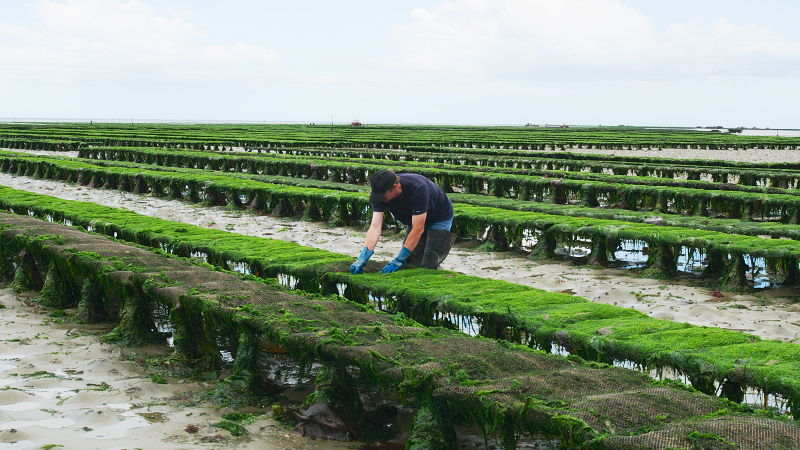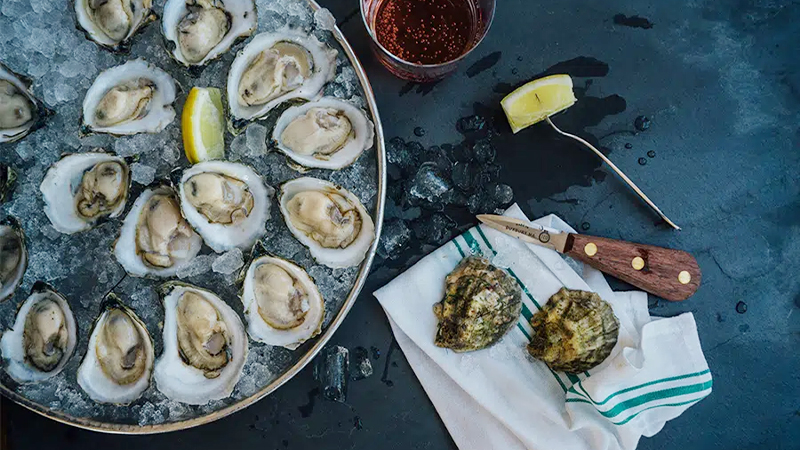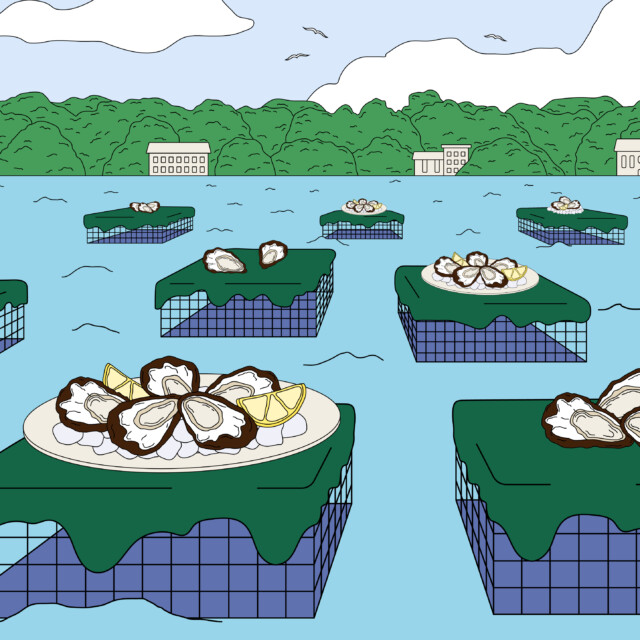About 35 minutes south of downtown Boston lies a coastal suburb that’s so synonymous with seafood — in particular oysters — that anyone who’s ever devoured a salty bivalve has likely encountered an Island Creek oyster. A more trained palate might recognize the name, but what exactly makes these oysters so widely popular? That would be the cold, turbulent, and salty waters of their breeding grounds in Duxbury Bay.
“Just like the growing conditions of grapes impact the flavor profile of wine, the same is true for how oysters are grown,” explains Chris Sherman, CEO of Island Creek Oysters. “Over the years, we half-jokingly coined the term “merroir” to describe this, and now it has caught on as a legitimate concept.”

When it comes to such marine terroir, Duxbury is unique because it is the confluence of a particular group of environmental conditions, explains Sherman: a white sand barrier beach with a sandy bottom and a thick layer of mud on top, cold water, high salinity, extreme tides, and an orientation to the prevailing southwest. These elements, specific to Duxbury Bay’s geography, ultimately influence the style of oyster produced — in this case, an oyster with a complex, saline flavor, firm and meaty texture, and a sweet, salty finish. This oyster can’t be replicated, because even if you take the same species (there are only five legally cultivated species in the United States, and Island Creek grows Crassostrea virginica, the most prolific oyster on the East Coast) there’s nowhere else on the East Coast that mirrors Duxbury’s geography. The same goes for wine: If you take a Sauvignon Blanc grape from France and plant it in Oregon, it’s going to taste different because of the regional particularities of its climate, soil, and aspect.
The four other oyster species that are legally recognized include the Belon species, also found on the East Coast, and Crassostrea gigas, Kumamoto, and Olympia on the West Coast, which are generically sweeter, rounder, and more deeply cut than East Coast varieties. Yet, even though they may share these likened qualities, West Coast species still differ from each other; an oyster from Northern California, such as those from Hog Island Oyster Co. in Marshall, will vary greatly from oysters grown at SoCal’s Carlsbad Aquafarm.
“Oysters grown in cold, northern waters will taste different from oysters in warmer, southern locales,” explains Kristen Shirley, oyster connoisseur and founder of La Patiala, the luxury encyclopedia. “Water temperature and salinity have a profound effect on oysters. They are filter feeders, so whatever is in the water — minerals, plankton, plants, and algae — also affects their flavors.”

In the Pacific Northwest, Kusshi oysters are a popular species. “They are a tumbled oyster, which is a process that strengthens their very deep shells; those deep shells result in a very plump oyster, and their flavor is both briny and delicate,” explains Carmen Ingham, executive chef of The Pointe at Wickaninnish Inn on the island of Tofino in British Columbia. At the Relais & Châteaux-owned property, Ingham is experienced in presenting year-round consistency in his dishes — and that includes oysters. In order to ensure the dishes, which vary depending on the season, maintain a briny freshness expected in oysters from the cold waters of British Columbia, the property sources from Deep Bay in the colder months of the year, and when the weather is warmer, oysters are sourced from the colder waters of Discovery Islands, even farther north than Deep Bay. Shirley explains that when cold waters increase in temperature, “oysters can taste flabby, without much flavor,” so this seasonal shift is significant to present the firm, sweet oysters that cold water farms are known for. Ingham adds that these characteristics pair well with Blue Mountain Gold Label Brut, a traditional method B.C. sparkling wine that offers refreshing lemon notes and toasty characters from 24 months on lees.
Even farther afield, on Portugal’s Algarve coast, João Oliveira — executive chef of Vista Restaurant at Bela Vista Hotel & Spa — credits the crystalline waters of the region for a high concentration of natural salt in oysters that develop with the tides. “They are not constantly submerged, so they gain more internal muscle and more natural fat,” explains Oliveira. He says delicate vegetable bases and herbs complement the fatty bivalves, sourced from a small-production farm very close to the hotel in the Vale da Lama area. For a wine pairing, he suggests Niepoort’s Moscatel Dócil (Ron Ron); the 100 percent Moscatel Galego is a typical variety from northern Portugal with an “incredible delicacy, little mineral, and lots of fresh fruit,” says Oliveira.
In New York City, Chad Palagi, chef de cuisine at Per Se, says the restaurant’s signature dish, Oysters and Pearls — pearl tapioca pudding topped with oysters and caviar — is best served with a brinier bivalve rather than a sweet one. The perfect oyster for this dish comes from none other than Island Creek Oysters in Duxbury. “They start off with a salty seaweed-like flavor and finish with butter and nutty notes; they are also the perfect size for the dish,” says Palagi.
This circles back to “merroir,” as the farming method and hand of the grower are two other factors that affect the oyster’s outcome. Sherman explains that he grows oysters to a particular specification for the Oysters and Pearl, a dish that’s also served at Thomas Keller’s French Laundry in Napa. For the famed dish from coast to coast, Hak Soo Kim, head sommelier for Per Se, suggests a pairing of Champagne Diebolt-Vallois Blanc de Blancs “Prestige” NV or Chablis, Domaine Billaud-Simon.

Sherman highlights a few more notable chefs using Island Creeks, including Michael Anthony at Gramercy Tavern, Thomas Allen at The Modern and Ken Oringer at Toro. Even though the chefs place their own spin on the oyster, Sherman says he sticks with the classics when it comes to pairing wine with Island Creeks. This includes “bright, acidic whites like Sancerre and Muscadet that can stand up to the salt,” as well as crisp Chenin Blancs that “pair great with oysters but will also work with the rest of your meal beyond the raw bar.”
Ultimately, terroir is as important for oysters as it is for wine, so when you’re ordering your next dozen on the half shell, consider taking a second look at the raw bar menu — the oysters are usually separated by East and West Coast, with their farm locale listed right next to the variety.
